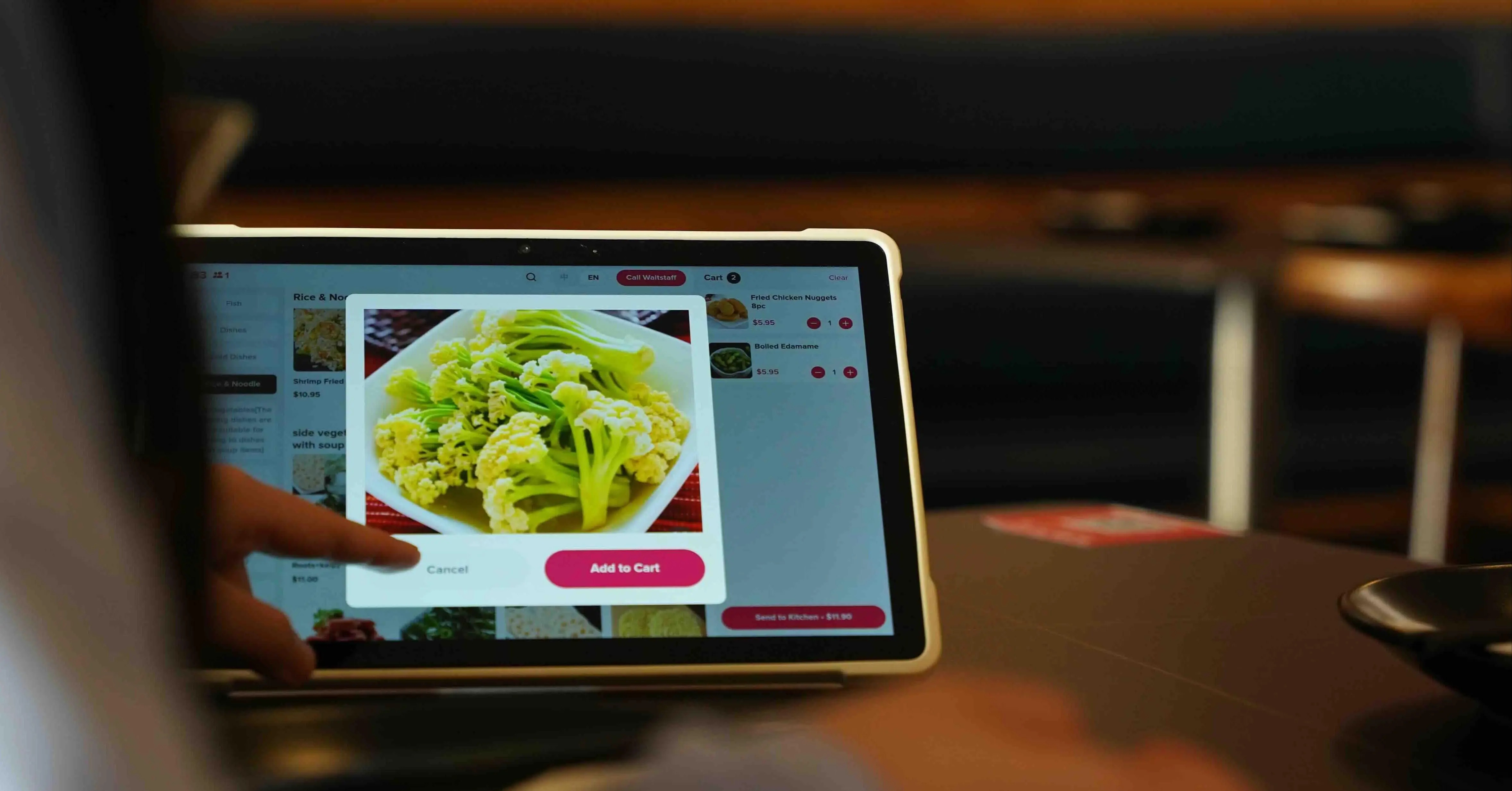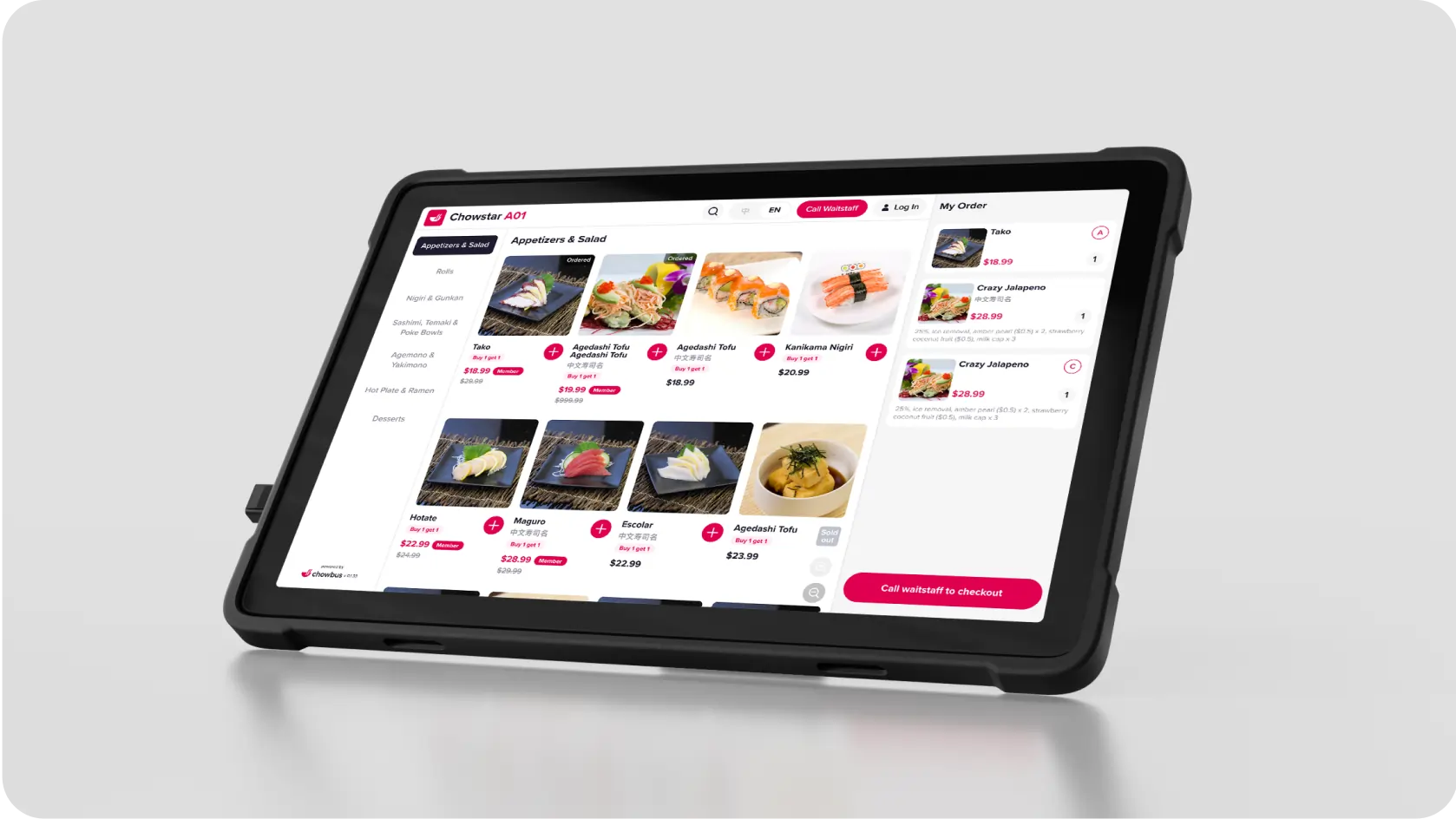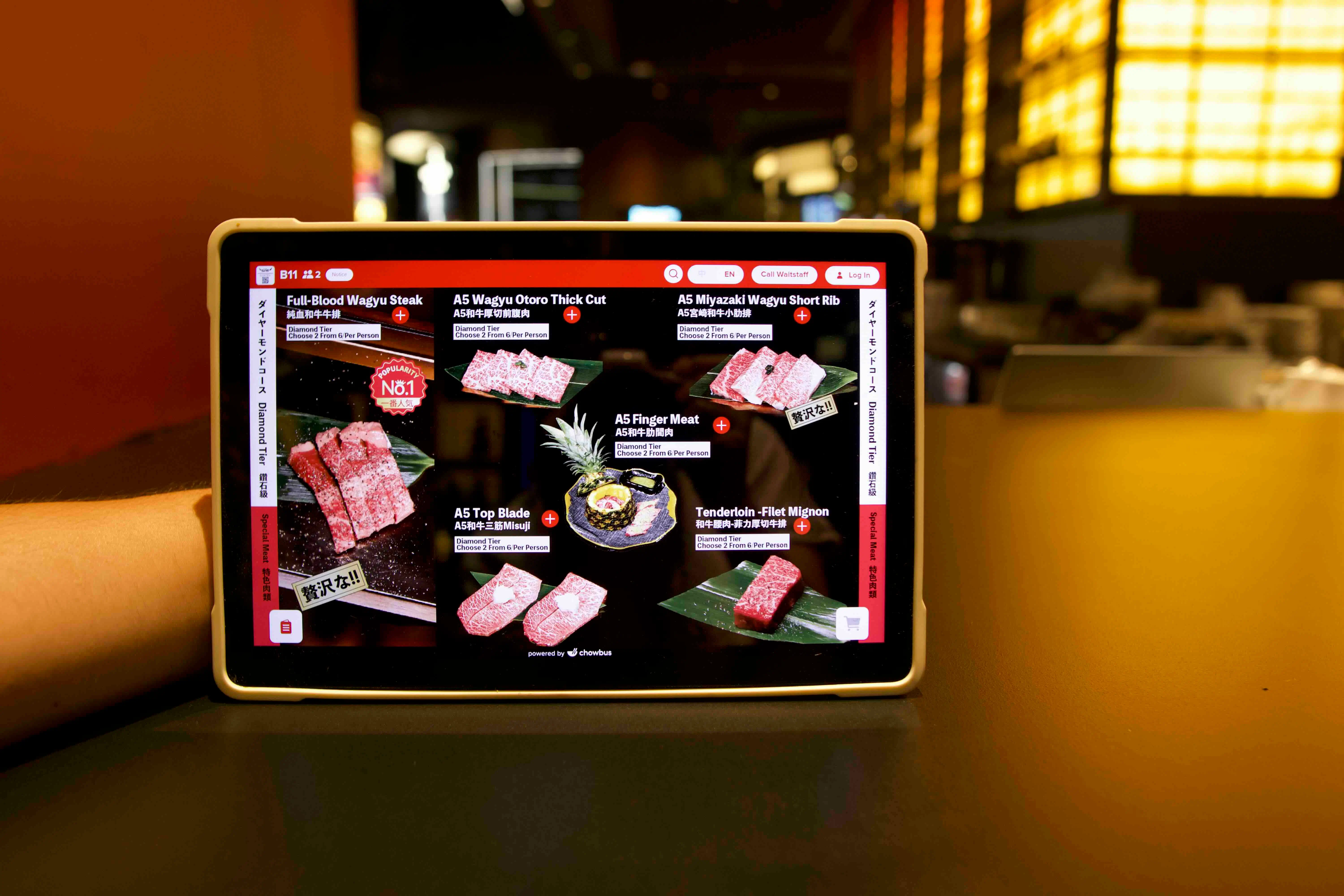
Restaurant Tablet Ordering and Tableside Ordering Systems are transforming the way restaurants operate and serve their customers.
If you’re a restaurant owner, planning to open a new eatery, or contemplating a switch in your service model, understanding these innovative systems is crucial.
In this blog, we’ll dive deep into Restaurant Tablet Ordering and Tableside Ordering Systems, explaining what they are, how they work, and the extensive benefits they offer to your business and your customers.
Let’s start with an in-depth look at what these systems are.

Restaurant tablet ordering is a modern approach in dining technology, where tablets are used for menu browsing and meal ordering. This innovative system comes in two forms: Server-Assisted and Self-Service.
This system is particularly effective in fast-paced dining settings, offering convenience and technological sophistication.
A Tableside Ordering System integrates technology directly at the dining table, empowering customers to place orders effortlessly. It typically includes QR Code Ordering, where guests use their smartphones to scan a code, access the menu, and order.
Handheld POS systems (often referred to as mobile point of sale or mPOS systems) are also part of this setup, allowing staff to input orders at the table for immediate processing. This system expedites the ordering process and significantly enhances the customer experience by reducing wait times and order inaccuracies.
Tablet and tableside ordering systems are reshaping the restaurant experience with innovative features. Here’s an overview of how they work:
These systems typically involve tablet POS or touchscreen devices that are either provided to customers at their table or integrated into the table itself. The hardware runs specialized software for menu browsing, order placement, and payment processing.
The software displays the restaurant’s menu, often with high-quality images and descriptions of each item. Customers can browse through different categories (like appetizers, mains, and desserts) and sometimes customize their orders (like adding toppings to a pizza or choosing a salad dressing).
Once the customer decides what they want to order, they can place the order directly through the tablet. This order is then transmitted electronically to the kitchen or bar, often integrating with the restaurant's existing point-of-sale (POS) system. In some systems, servers are notified of the order and may confirm with the customer before it's sent to the kitchen.
After finishing their meal, customers can use the tablet to view their bill, split it among multiple people if needed, and process payment. The system may support various payment methods, including credit/debit cards, mobile payments, and sometimes cash transactions with server assistance.
Many tablet ordering systems also include options for customers to leave feedback about their experience. They might also integrate with loyalty programs, allowing customers to earn points or rewards for their orders.
The system can collect customer preferences and order history data, which can be used for personalized marketing and menu optimization.
Overall, tablet and tableside ordering systems represent a significant shift in the dining experience, offering a blend of convenience, efficiency, and modern technology.

Embracing Restaurant Tablet Ordering and Tableside Ordering Systems is a game-changer for both the efficiency of restaurant operations and customers’ dining experience. Let’s explore the key benefits these systems offer.
Incorporating these technologies signifies a step towards modern, efficient, and customer-focused dining.
The adoption of tablet-based restaurant ordering systems, including iPad POS solutions, is on the rise, and for good reason. Let's delve into why more restaurants are making the switch:
1. Enhanced Customer Experience: Tablets offer interactive menus and high-quality images, giving customers a detailed and engaging overview of their dining options. This not only aids in decision-making but also elevates the overall dining experience.
2. Streamlining Efficiency and Speed: A tablet ordering system for restaurants directly links orders to the kitchen, streamlining service and reducing errors. This efficiency translates to quicker service, happier customers, and increased turnover.
3. Cutting Labor Costs: Implementing restaurant ordering tablets can save labor costs. These devices manage tasks like order taking and payment processing, allowing for a leaner staff without compromising service quality.
4. Data-Driven Insights and Personalization: Tablet-based systems offer valuable insights into customer preferences, which can be leveraged to tailor the dining experience and refine marketing strategies.
5. Improved Order Accuracy: With customers directly inputting their orders, tablet ordering systems for restaurants drastically reduce order errors, ensuring that guests receive exactly what they want.
6. Dynamic Menu Management: The restaurant tableside ordering system allows for real-time menu updates, instantly displaying daily specials or unavailable items, which is more efficient than traditional paper menus.
7. Hygienic and Contactless Service: In response to health concerns, such as during the COVID-19 pandemic, these systems offer a hygienic, contactless ordering method, minimizing physical interactions and enhancing safety.
8. Environmentally Friendly: Lastly, restaurant tablet ordering systems contribute to a greener operation by reducing the need for paper menus and receipts, aligning with eco-friendly business practices.

Choosing the right Restaurant Point of Sale (POS) system with tablet ordering involves several important considerations. Here's a guide to help you make an informed decision:
Before exploring options, assess your restaurant’s specific needs. Consider factors like the size of your establishment, the volume of transactions, the complexity of your menu, and whether you offer services like delivery or takeaway.
The system should be user-friendly for both your staff and customers. Tablets should have an intuitive interface, making it easy for staff to take orders and for customers to place them if self-ordering is an option.
Check if the POS system can seamlessly integrate with your existing software, such as inventory management, accounting, and CRM systems. This integration can streamline operations and reduce manual work.
Ensure the tablets and the software are reliable and can handle high volumes of orders without technical glitches, especially during peak hours.
Look for a system that allows you to customize menus and pricing, and possibly even the layout of the tablet interface to match your restaurant’s theme.
A good POS system should offer comprehensive reporting and analytics to help you understand sales patterns, popular items, customer preferences, and other insights that can drive business decisions.
Ensure the provider offers quality customer support and training for your staff. Good support can significantly ease the transition to a new system.
Consider the total cost of ownership, including hardware, software, and any recurring subscription fees. Compare these costs against the expected benefits and efficiency gains.
The system should be secure and comply with payment industry standards to protect sensitive customer data, like credit card information.
As your business grows, your POS system should be able to scale with you, whether that means adding more tablets, features, or integrating with new technologies.
Opt for a system that offers a trial period or demo so you can test its functionality in your restaurant environment.
Check reviews from other restaurant owners and seek recommendations. First-hand user experiences can provide valuable insights into the system’s performance and reliability.
Remember, the right POS system can enhance the efficiency of your operations, improve customer satisfaction, and ultimately contribute to the success of your restaurant. Take your time to research and choose a system that best fits your restaurant's unique needs.

Chowbus POS stands out as a leading restaurant tablet ordering system, offering a comprehensive solution that goes beyond mere ordering. It's designed to enhance the dining experience for both customers and staff. This system allows for more speed and sales, offering a one-stop ordering and payment solution. It’s not just about ordering. It’s about creating an efficient, contactless experience that caters to the modern diner’s preferences.
1. Efficiency and Convenience: With direct kitchen integration, orders are processed faster, reducing wait times and improving table turnover by up to 25%.
2. Cost-Effective: Reduces labor costs and print expenses, with an average saving of $8,000 per month for restaurant owners.
3. Enhanced Customer Experience: Big screen displays of dish photos provide a vivid browsing experience. It also allows for immediate seating and ordering, reducing customer wait times.
4. Data Collection and Loyalty Programs: Collect valuable guest data for targeted marketing and loyalty programs, leading to a higher rate of returning customers.
5. Operational Excellence: Streamlines waiter workflows, minimizing errors and enhancing overall operational efficiency.
Restaurant tablet ordering and tableside ordering systems provide numerous benefits for restaurant owners aiming to improve customer satisfaction, streamline operations, and maintain competitiveness in the ever-evolving dining landscape.
As technology progresses, these systems are set to play an increasingly crucial role in shaping the future of the restaurant industry. To guarantee success, it is important to evaluate your options carefully, select the system that best fits your restaurant’s needs, and embrace the innovative opportunities offered by tablet based restaurant ordering systems.
Ready to take your restaurant to the next level with tablet ordering and tableside systems? Book a free demo or consultation with Chowbus POS, a leading provider of restaurant technology solutions. Discover how our innovative POS system with tableside ordering capabilities can transform your restaurant’s operations, enhance the dining experience, and boost your bottom line.
Don’t miss out on the opportunity to stay ahead of the competition. Contact us today to schedule your consultation and see the benefits of our cutting-edge technology. Your success is just a click away!

Dive into our FAQ section to explore everything you need to know about Restaurant Tablet Ordering Systems, including insights on Tableside Ordering and Tableside Service.
Tableside ordering is a convenient dining experience where restaurant staff take orders directly at the customer's table, using handheld devices, rather than having patrons place orders at a central location like a counter or cashier.
Tableside service refers to a dining experience where restaurant staff take and serve orders directly at the customer’s table. This personalized approach enhances the overall dining experience, allowing patrons to interact with the server and customize their orders to their preferences. Tableside service often includes menu explanations, wine recommendations, and preparing certain dishes right at the table, creating a memorable and enjoyable dining atmosphere.
